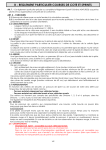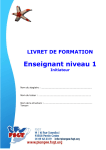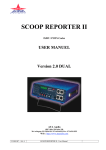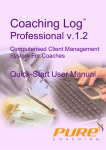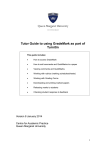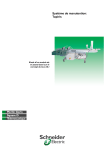Download Aviation Maintenance Technology
Transcript
Portland Community College Aviation Maintenance Technology Core Outcome Assessment Evaluation: Critical Thinking and Problem Solving Skills AMT Subject Area Committee 5/17/2010 Portland Community College - Aviation Maintenance Technology – Critical Thinking and Problem-Solving Outcomes Assessment Table of Contents Introduction .................................................................................................................... 3 Numbered List of Critical Thinking and Problem Solving Skills ............................. 5 Submission #1 – AMT 115 Project 10 &11.................................................................. 6 Submission #2 – AMT 109 Project 12 ........................................................................ 11 Submission #3 – AMT 218 Project 9 .......................................................................... 14 Submission #4 – AMT 204 Project 8 .......................................................................... 15 Submission #5 AMT 203 Project 20a ........................................................................ 16 Submission #6 – AMT 123 Project 6 & 7 ................................................................... 18 AviationMaintenanceTechnologyLAPlanCompleted2010.docx 2 Portland Community College - Aviation Maintenance Technology – Critical Thinking and Problem-Solving Outcomes Assessment AMT Core Outcomes - Critical Thinking and Problem Solving Question: How well is the Aviation Maintenance Technology program curriculum designed to facilitate program students achieving Critical Thinking and Problem Solving skills? Response: Critical Thinking and Problem Solving skills are key components to the incredibly safe aviation industry in the United States. Even though there is a high degree of government regulation of the aviation industry, safety is not a result of only lock-step adherence to rule after rule. Safe aircraft operations occur hour after flight hour, day after day because of individuals and teams of personnel that are able to summon up imaginative yet critical thought toward the resolution of problems that present themselves. The students of the Aviation Maintenance Technology program receive multiple opportunities, in nearly every course, to demonstrate Critical Thinking and Problem Solving skills. Central to operating aircraft safely, from the AMT’s perspective, is the airworthiness of each component and part of an aircraft, as complex as an aircraft turbine engine or as seemingly simple as a bolt or rivet. The condition of Airworthiness of an aircraft or component part is determined by the aviation maintenance technician using standards established both by the manufacturer of the component and the aviation governing agency. Airworthiness means the aircraft (or its component part) conforms to its type design (or properly altered condition) and is in a condition for safe operation. (FAA definition) The skills of critical evaluation and problem resolution are imperative for the success of our students within the aviation industry. These skills are also helpful in life. To the end that Critical Thinking and Problem-Solving skills are mandatory in the aviation industry, the AMT program dedicates two degree and certificate outcomes to them. • Make independent and accurate airworthiness judgments in the process of inspecting and maintaining aircraft structures and powerplants in accordance with applicable airworthiness requirements. • Troubleshoot aircraft structures, powerplants and their associated systems with a discerning recognition of the specific malfunction within the scope of the overall aircraft and associated systems and accomplish the correct maintenance action that will allow approval for return-to-service of the affected items. The six example project summaries that follow were examined by the full SAC of the AMT program. Each project was evaluated against the PCC Core Outcomes skill statements for Critical Thinking and Problem-Solving by the presenting instructor. Then, with some preliminary description by the instructor of the project context, each project was discussed in the SAC forum. Finally, each project was assigned several numbered skill descriptions, highlighting the skill demonstrated by students accomplishing the project. The PCC list of skill statements taken from the PCC website at http://www.pcc.edu/resources/academic/coreoutcomes/co-criticalthinking-problemsolving.html was numbered for simplified recording during the work sessions. The lists and table are included for clarification to the reader AviationMaintenanceTechnologyLAPlanCompleted2010.docx 3 Portland Community College - Aviation Maintenance Technology – Critical Thinking and Problem-Solving Outcomes Assessment The matter of whether an AMT student demonstrates Critical Thinking and Problem-Solving skills is simplified by an overall program requirement. AMT program competencies are articulated by the certificating agency, the Federal Aviation Administration. In order to meet those requirements, all PCC AMT students must complete all required projects to at least a satisfactory level, in each course. If the student does not meet the competency level of even one project within a course, the student will not pass the course and must either repeat the course or fail to gain a Certificate of Completion. Having identified the skills of Critical Thinking and Problem-Solving within each of the following representative course projects, we are confident that AMT program students are assessed significantly and meet the goals of PCC to be Critical Thinkers and ProblemSolvers upon completion of the AMT program. AviationMaintenanceTechnologyLAPlanCompleted2010.docx 4 Portland Community College - Aviation Maintenance Technology – Critical Thinking and Problem-Solving Outcomes Assessment Think Critically and Imaginatively 1. Engage the imagination to explore new possibilities. 2. Formulate and articulate ideas. 3. Recognize explicit and tacit assumptions and their consequences. 4. Weigh connections and relationships. 5. Distinguish relevant from non-relevant data, fact from opinion. 6. Identify, evaluate and synthesize information (obtained through library, world-wide web, and other sources as appropriate) in a collaborative environment. 7. Engage the imagination to explore new possibilities. 8. Reason toward a conclusion or application. 9. Understand the contributions and applications of associative, intuitive and metaphoric modes of reasoning to argument and analysis. 10. Analyze and draw inferences from numerical models. 11. Determine the extent of information needed. 12. Access the needed information effectively and efficiently. 13. Evaluate information and its sources critically. 14. Incorporate selected information into one’s knowledge base. 15. Understand the economic, legal, and social issues surrounding the use of information, and access and use information ethically and legally. AviationMaintenanceTechnologyLAPlanCompleted2010.docx Problem-Solve 16. Identify and define central and secondary problems. 17. Research and analyze data relevant to issues from a variety of media. 18. Select and use appropriate concepts and methods from a variety of disciplines to solve problems effectively and creatively. 19. Form associations between disparate facts and methods, which may be cross-disciplinary. 20. Identify and use appropriate technology to research, solve, and present solutions to problems. 21. Understand the roles of collaboration, risk-taking, multi-disciplinary awareness, and the imagination in achieving creative responses to problems. 22. Make a decision and take actions based on analysis. 23. Interpret and express quantitative ideas effectively in written, visual, aural, and oral form. 24. Interpret and use written, quantitative, and visual text effectively in presentation of solutions to problems. 5 Portland Community College - Aviation Maintenance Technology – Critical Thinking and Problem-Solving Outcomes Assessment Sample Project #1 – Evaluation Submitted by Marshall Pryor Projects 10 and 11 provide a representation from AMT 115 – Aircraft Structures and Inspections, from the Airframe component of the program coursework. They two projects are complimentary and sequential in nature. Upon the successful completion of Project 10, the student will advance to the preparation and presentation of Project 11. Project 10 essentially asks the student to demonstrate the ability to read, analyze and apply a safety compliance directive meant to assure the correction of an unsafe condition that exists in an aircraft. Project 11 asks the student to demonstrate the ability to correctly read, analyze and apply while directing / instructing other “workers” to do the same. The main goal of the second project is to facilitate students meeting other PCC identified outcomes in the Communications skills area. The Critical Thinking and Problem Solving skills identified in Project 10 and 11 are as follows. Skill 2 – Throughout the AMT coursework, students are asked to restate, to the instructor, in their own words, the instructions or directives regarding the practical task at hand. In this case, the is asked, with some guiding questions, to state the important components of the directive in his own words. Skill 5 – When accomplishing Project 10, the student must distinguish among the data presented in the directive, the relevancy of that data to the unique serialized aircraft in question. Applicable to Project 11, the student, acting as a “supervisor” will cull from the directive, only the pertinent data for his “crew” to act upon. Skill 6 – This skill is demonstrated in Project 11 through the interaction that should take place between “lead mechanic” and “crew”. Skill 17 – This skill is demonstrated in the practical research in the aircraft maintenance manuals, the component Type Certificate Data Sheet, the Regulatory Guidance Library where the Airworthiness Directive is archived and finally the appropriate aircraft maintenance records. Skill 20 – This skill is demonstrated by the student properly identifying the appropriate tools required for the corrective action, if needed. Skill 23 – This skill is demonstrated by the students in Project 11 through the development and presentation of estimates of time and costs represented by the appropriate repair or alteration action. AviationMaintenanceTechnologyLAPlanCompleted2010.docx 6 Portland Community College - Aviation Maintenance Technology – Critical Thinking and Problem-Solving Outcomes Assessment Project 10 AD Search, Interpretation and Summary Name: GOAL: Primary - Demonstrate student ability to research and interpret Airworthiness Directives. Secondary – Demonstrate the student ability to convey technical information in written and oral format to a group of colleagues or supervisees. USING THE FORMAT DEMONSTRATED AND DISCUSSED DURING CLASS, PERFORM THE FOLLOWING PROJECT. 1) Identify several Airworthiness Directives that (1) might apply to your assigned aircraft or (2) be relevant to an aircraft of interest to you through current or prior association. Be prepared to discuss the various concerns of the AD’s you propose with your instructor. 2) Chosen AD #: ___________________ 3) _________ (Instructor Initials needed prior to proceeding. This assures no duplication in the choice of AD with other students and adequate level complexity to the chosen AD.) 4) Read through the chosen / instructor approved Airworthiness Directive (AD) and associated service information provided by the manufacturer. 5) Note the information needed to answer at least the following questions. Answer additional questions that might need to be answered to show complete understanding of the AD. a) b) c) d) e) f) g) h) i) j) k) l) m) n) This AD applies to what Make of aircraft? This AD applies to what Model aircraft? What serial numbers are affected by this AD? What is the previous amendment number(s) of this AD? Does this AD recur ? At what rate? What is the issue of safety that this AD addresses? Which service bulletin(s) are associated with this AD? Which method of compliance for this AD did you accomplish? What items are not clear regarding the compliance method for this AD? Is this AD written in the “plain language” format? What special tools, fixtures, or procedures are required? What will be the cost of accomplishing this AD? Other items of interest developed during class discussion time. Make note of any questions you have regarding any item in this AD. 6) Make a proper maintenance entry, according to 14 CFR Part 43, for the assigned AD, on the attached log book form using the information gathered by answering above questions. This exercise will be graded by the instructor. ____/25 7) Using this synopsis as your reference notes, be prepared to make an oral presentation to the class of between five and eight minutes, reviewing the summary of your research. Guidelines for this section of the project are described in Project 11. AviationMaintenanceTechnologyLAPlanCompleted2010.docx 7 Portland Community College - Aviation Maintenance Technology – Critical Thinking and Problem-Solving Outcomes Assessment Maintenance Record / Log Book AIRFRAME LOG DATE T.I.S. DESCRIPTION OF MAINTENANCE OR INSPECTION PERFORMED AviationMaintenanceTechnologyLAPlanCompleted2010.docx 8 Portland Community College - Aviation Maintenance Technology – Critical Thinking and Problem-Solving Outcomes Assessment Project 11 AD Interpretation and Summary - Class Presentation GOAL: Primary – Encourage the student to develop an ability to convey technical information in written and oral format to other supervised, certificated mechanics. Secondary – Demonstrate student ability to research and interpret Airworthiness Directives. USING THE FORMAT DEMONSTRATED AND DISCUSSED DURING CLASS, PERFORM THE FOLLOWING PROJECT: 1) Using the synopsis you developed in Project 10 as reference notes; prepare an oral presentation of between four to six minutes in length. 2) Prepare a written script or outline of your presentation. Submit a copy to the instructor one day prior to your presentation. 3) For this presentation think in terms of the following scenario: a) You are a shop supervisor, director of maintenance or shift lead. b) You are presenting the information in summary that will help your maintenance team understand the Airworthiness Directive and how to complete it legally, safely and efficiently. c) You need to be concerned with fleet maintenance costs. One way to do this is by reducing the total time that all the mechanics will use in comprehending the scope and detail of the AD. d) You are also very concerned with doing the corrective action in a safe manner. e) You are the “expert” regarding this AD. f) Your objective is to facilitate understanding of the AD to keep costs down associated with compliance to the details of the AD. 4) Include, at minimum, these points of information during your presentation: a) b) c) d) e) Background of the cause of the issuance of the AD. The actual current safety issue being addressed The reference data each worker will need. A list and description of tools need to accomplish the work required. A step by step action plan for accomplishing the work required, including clear descriptions of the alternative steps and the reasons for those alternative. f) A description of the forms and/or records that need to be completed following the corrective action. g) Simple cost analysis of the corrective action for: 1) a fleet of five (5) aircraft 2) $100 / hour shop rate 5) You must use at least one type of visual aid. Feel free to use as many different kinds of visual aids with which you feel comfortable. Visual aids will help your mechanics AviationMaintenanceTechnologyLAPlanCompleted2010.docx 9 Portland Community College - Aviation Maintenance Technology – Critical Thinking and Problem-Solving Outcomes Assessment focus in on the inspection issues. Your instructor can assist you in reserving or obtaining the following: a) Transparency film and copies – Color or B/W, 3-5 sheets b) PowerPoint presenter projector and computer c) Visual Presenter (this tool magnifies and projects smaller objects for viewing via projector) d) Digital camera e) Copies of handouts f) Actual or similar example parts. 6) Prepare all visual aids at least one day prior to your presentation. 7) Familiarize yourself with all the presentation equipment you will be using, at least one day in advance of your presentation. Load any powerpoint files onto the desktop of the podium computer prior to your presentation. 8) Finally, rehearse your presentation at least once prior to your actual delivery. The evaluation of this project is to ensure a greater measure of student participation. As this is not a speech class, less grading emphasis will be placed on delivery and more on attempt to fulfill the essence of the project scenario. It is my desire to encourage each student to seek further learning in areas of the public presentation of information often associated with professional positions that are supervisory in nature. The criteria for grading of this project are as follows: (50 points total) (____/10pts) - Staying within time limit – maximum and minimum. (____/25pts) - Presenting a complete interpretation and steps of action for complying with the Airworthiness Directive. (____/10pts) - Variety, quality, quantity and appropriateness of visual aids used to explain the AD.) (____/ 5pts) - General connection with audience, i.e., voice, eye contact, etc. AviationMaintenanceTechnologyLAPlanCompleted2010.docx 10 Portland Community College - Aviation Maintenance Technology - Critical Thinking and Problem-Solving Outcomes Assessment PROJECT SHEET Project 12 – Rigging Aircraft AILERONS Name: Project Partners: PURPOSE: Facilitate the student understanding of the methods and tools for proper rigging of the ailerons and associated control systems. OBJECTIVES: • Demonstrate knowledge of system functioning. • Demonstrate correct rigging of ailerons and associated controls. INSTRUCTIONS: In assigned teams, assure the correct rigging of the ailerons and associated control system of the assigned aircraft. Aircraft Model: ________________________S/N: _______________________ Aircraft Pre-project Inspection ____________ System De-Rigging ________________ The instructor must sign off the above prior to further progress on the rigging project. Follow the instructions outlined in the aircraft maintenance manual or service manual as appropriate. Retrieve information from the correct documents. • Document Number(s): ______________________________________________ • Verify specified limits in all resource documents. __________________________ Limits: -------------------------------------------------------------------------------------------------------------- Up limits ________________ [+] ______ / [ - ] _______ Down limits ______________ [+] ______ / [ - ] _______ AviationMaintenanceTechnologyLAPlanCompleted2010.docx 11 Portland Community College - Aviation Maintenance Technology - Critical Thinking and Problem-Solving Outcomes Assessment PROJECT SHEET Actual Travel: Check conformity of the chosen control surfaces --------Propeller Protractor: Right Up: __________ (Out-of-limits: ______) Digital Protractor: Up: __________ (Out-of-limits: ______) Down: ________ (Out-of-limits: ______) Left Down: ________ (Out-of-limits: ______) Up: __________ (Out-of-limits: ______) Up: __________ (Out-of-limits: ______) Down: ________ (Out-of-limits: ______) Down: ________ (Out-of-limits: ______) On a separate sheet, complete a maintenance entry for this maintenance. The action prescribing this maintenance was a 100-hour inspection. Be prepared to demonstrate and discuss your findings with the instructor prior to putting away equipment and returning the aircraft to display condition. Assure proper storage of tools and resources. Assure aircraft is returned to better-than-pre-project-condition. On a separate sheet, please complete a discrepancy sheet for: • any remaining un-airworthy conditions of the ailerons or associated structures of the aircraft, with a full description of the un-airworthy condition and, • parts required to bring the un-airworthy part into compliance. Attach all the paperwork to the project sheet Turn in your project sheet for grade recording following “Pink Sheet” sign-off. EVALUATION CRITERIA: Following AMM instructions: Understanding of process: Better than pre-project condition: AviationMaintenanceTechnologyLAPlanCompleted2010.docx _____/10 _____/10 _____/6 Total: _____/26 (Attachments) 12 Portland Community College - Aviation Maintenance Technology - Critical Thinking and Problem-Solving Outcomes Assessment PROJECT SHEET This project sheet is one of three similar projects used to teach, demonstrate, and practice the rigging of the primary flight controls of an airplane. It draws on information and projects earlier in this class, as well as from previous classes in the program. This Project includes the following Critical Thinking areas: • • • • • • • • Identify, evaluate and synthesize information (obtained through library, world-wide web, and other sources as appropriate) in a collaborative environment. Reason toward a conclusion or application. Evaluate information and its sources critically. Identify and define central and secondary problems. Research and analyze data relevant to issues from a variety of media. Identify and use appropriate technology to research, solve, and present solutions to problems. Make a decision and take actions based on analysis. Interpret and express quantitative ideas effectively in written, visual, aural, and oral form. AviationMaintenanceTechnologyLAPlanCompleted2010.docx 13 Portland Community College - Aviation Maintenance Technology - Critical Thinking and Problem-Solving Outcomes Assessment PROJECT SHEET Project 9 - Cold Cylinder Check Name: Purpose: To allow the student to demonstrate understanding of how to perform the troubleshooting technique of isolating the source of an engine miss or rough running. Project Components: 1. Resource documents and tools: Class notes on Cold Cylinder Test Infrared thermometer Contact thermometer C-125 Run-up Stand or Assigned Aircraft 2. THE INSTRUCTOR MUST BE PRESENT DURING ALL ENGINE RUNNING. ASSURE POWER SOURCE IS REMOVED FROM ENGINE TEST STAND WHEN TROUBLESHOOTING ENGINE OR COMPONENTS. 3. The Instructor will need to impose a fault for purposes of simulation. 4. Follow the procedure, step by step, as outlined in your class lecture notes. a) b) c) d) e) f) g) h) i) j) k) l) m) Face Aircraft into the wind. Clear run-up area of any potential FOD. Perform Pre-Run inspection of powerplant. Establish personnel for fire and safety watch. Observing all safety precautions, start engine and run at 1000 rpm till minimum oil temperature is established. Run-up to factory recommended rpm and perform magneto drop check. Record results, shut down engine, and allow engine to cool completely. Using recorded results of magneto drop check, determine the magneto with the fault. Start the engine, and run it on the defective magneto circuit only for 30 – 45 seconds at 1000 rpm. Shut engine down, and immediately use temperature monitoring equipment listed above to determine the “Cold Cylinder”. Once the individual cylinder has been identified, use your knowledge of the cylinder function and the ignition system to isolate and identify the cause of the malfunction. Discuss your findings with the instructor. After receiving approval from the instructor, repair the defective condition, and Run-up the aircraft engine to verify proper operation. Evaluation: Safety______ 10pts Troubleshooting procedure ______ 10pts Repair _____ 10pts Core Outcomes: “Critical Thinking and Problem Solving” - Determine the extent of information needed. Evaluate information and it’s sources critically. Identify and define central and secondary problems. Reason toward a conclusion or application. Make a decision and take actions based on analysis. Formulate and articulate ideas. Identify, evaluate and synthesize information in a collaborative environment. AviationMaintenanceTechnologyLAPlanCompleted2010.docx 14 Portland Community College - Aviation Maintenance Technology - Critical Thinking and Problem-Solving Outcomes Assessment AIRCRAFT ELECTRICITY III Project 8 Assemble and operate a complete DC generator, regulator and battery circuit. PCC critical thinking and problem solving core outcomes: Formulate and articulate ideas Determine the extent of information needed Evaluate information and its sources critically Interpret and express quantitative ideas effectively in written, visual, aural, and oral form Project considerations: Wear Safety Glasses when operating equipment Each step is worth 10 percent. Project success minimum is 70 percent. An incorrect oral answer will receive a 5 percent deduction. If the retry answer is incorrect also, an additional 3 percent will be deducted. You must pass each step prior to moving to the next step. Project Steps: 1. Connect the generator to the Voltage Regulator unit correctly using a wiring diagram from the student packet. Attach your meter correctly to the shunt. ______ 2. With the generator turning, what must operate inside the voltage regulator unit for generator voltage to be made available to the bus? ______ 3. Now bring generator on-line. Which direction is current flowing in the generator field wire? ______ 4. Now bring battery on-line. How much current is flowing to/from the battery? ______ 5. Which direction is current flowing through the shunt? ______ (Now disconnect the battery.) The instructor will attach the load-bank to the bus. Monitor and record the approximate maximum current draw before the voltage at the bus drops below 13.0v. Now the instructor will turn off the load-bank and bring the battery back on-line. 6. If the generator were to be shut down: a. What will occur inside the voltage regulator? ______ b. What happens to the current flow through the shunt? ______ 7. How would the field of this generator be properly flashed a. At the Voltage Regulator? ______ b. What position must the switches be in for the field to be flashed? ______ c. Which way does current flow in the field wire when the field is being flashed? ______ Total points = ________ AviationMaintenanceTechnologyLAPlanCompleted2010.docx 15 Portland Community College - Aviation Maintenance Technology - Critical Thinking and Problem-Solving Outcomes Assessment Aircraft Electricity II Project 20a Troubleshoot landing gear position and warning systems. PCC critical thinking and problem solving core outcomes: Formulate and articulate ideas Reason toward a conclusion or application Access the needed information effectively and efficiently Evaluate information and its sources critically Make a decision and take actions based on analysis Job description: Your repair station's work order requests that the landing gear electrical system on the Queen Air be checked out. Your initial inspection reveals that several switches and other components are corroded or damaged and need to be replaced. The customer approves replacement of all components that are found to be defective. The following is the list of the components using your nomenclature. The parts department needs the exact part numbers, quantities, and the parts catalog figure and index numbers. (11pts) AIRCRAFT MODEL: _______________________ S/N_________________ Complete this list first and present it to the instructor for grading. possible nomenclature Part Number Figure - Index landing gear relay CB LG motor CB landing gear ind. CB gear up and down position lights landing gear control switch engine throttle warning switches NLG up lock indicator switch NLG down lock indicator switch MLG down indicator switches MLG up indicator switches landing gear squat switches Instructor grade/sign-off____________ _____________ Identify the location on the aircraft of each of the items: possible nomenclature landing gear relay CB LG motor CB landing gear ind. CB gear up and down position lights landing gear control switch engine throttle warning switches NLG up lock indicator switch NLG down lock indicator switch MLG down indicator switches MLG up indicator switches landing gear squat switches Part Number AviationMaintenanceTechnologyLAPlanCompleted2010.docx Quantity Location 16 Portland Community College - Aviation Maintenance Technology - Critical Thinking and Problem-Solving Outcomes Assessment LIST THE FIGURE OR PAGE # OF YOUR REFERENCE FOR THE FOLLOWING: 1. There are two switches on each MLG drag link (drag brace). a. Which switch operates in which system? (1pt) LH inboard: RH inboard: LH outboard: RH outboard: b. In what landing gear position are these switches in their normally closed positions? (1pt) c. Where is the information found to adjust the indicator switches? (1pt) 2. a. How are the throttle switches adjusted? (List the steps involved) (1pt) b. Which throttle position is the switch in its normally closed position? (1pt) c. Which throttle switch on the aircraft actually needs to be adjusted? (1pt) 3. a. Which systems are operated by the two landing gear safety switches? (4pts) 1. 2. 3. 4. b. In what aircraft condition are the switches in their normally closed position? (1pt) Don't forget your references! AviationMaintenanceTechnologyLAPlanCompleted2010.docx 17 Portland Community College - Aviation Maintenance Technology - Critical Thinking and Problem-Solving Outcomes Assessment LYCOMING 0-290G ENGINE MAGNETO TIMING PROJECTS #6 & #7 These are both graded projects. DESCRIPTION: Time the magnetos on the Lycoming 0-290G engine. Run the Lycoming 0-290G engine on the test stand. Do a magneto operational check. CAUTION: EXERCISE EXTREME CARE AROUND OPERATING ENGINES! INSTRUCTIONS: 1. Use proper safety gear including YOUR EYE & HEARING PROTECTION 2. These two projects are Team Projects. Everyone on the team is to participate equally in the project to receive credit, but will receive individual grades. 3. The Instructor will assign the team an engine to work on. Inspect your engine for any obvious defects. 4. Perform a preliminary run-up of the engine and a magneto drop check. Use the 0-290G Engine run-up checklist enclosed. Be sure to always record Magneto drops on paper and DO NOT attempt to commit them to memory. Remember to observe all appropriate safety precautions. Make sure the run-up area is roped off and that an Instructor is present during the run-up. 5. Remove the magnetos from the engine and perform Internal Timing on both of them. Use the appropriate Master Manual for your magneto. DO NOT use Service Manual copies that are in your desks. Note: Both magnetos are LEFT HAND! 6. Present your Internally Timed magnetos to the Instructor with the timing light still connected. The Instructor will check Internal Timing. 7. Now install the magnetos on the engine and perform Magneto-To-Engine timing. CAUTION: When performing Magneto-To-Engine timing the spark plug leads must be disconnected or the distributor caps must be removed. There is a danger of great personal injury from the engine kicking over or starting while being rotated by hand or the starter. NOTE: The ignition switch should be in the BOTH position while timing, or both “P” leads removed. This will prevent the points from being grounded through the switch. 8. Check out from the Tool Room; the 0-290G Operators Manual, timing light, top-dead-center indicator, and “T” Bar handle for rotating the engine. Follow the procedures in Section 5 for Magneto-To-Engine timing. Notify the Instructor when you have completed your Magneto-To-Engine timing. Leave the timing light connected to the engine so the timing can be verified by the Instructor. Perform a post-operational run-up of the engine. Remember to always record Magneto drops on paper and DO NOT attempt to commit them to memory. Also remember to observe all appropriate safety precautions. Make sure the run-up area is roped off and that an Instructor is present during the run-up. 9. AviationMaintenanceTechnologyLAPlanCompleted2010.docx 18 Portland Community College - Aviation Maintenance Technology - Critical Thinking and Problem-Solving Outcomes Assessment LYCOMING 0-290G ENGINE TEST STAND PROJECT CHECKLIST 1. Perform preliminary run-up (Instructor must be present) 2. Use proper safety gear including YOUR EYE & HEARING PROTECTION 3. Follow Run-Up Check-List (see next page). 4. Record Magneto Drops: 5. Remove magneto distributor caps 6. Remove magnetos 7. Set internal timing 8. Have Instructor check 9. Set Magneto-To-Engine timing 10. Have Instructor check 11. Perform final run-up (Instructor must be present) 12. Use proper safety gear including YOUR EYE & HEARING PROTECTION 13. Follow Run-Up Check-List (see next page) 14. Record Magneto Drops: 15. Use correct Troubleshooting techniques (Be able to answer troubleshooting questions) 16. Safe the engine (See engine shut-down on next page) BOTH RPM: BOTH RPM: AviationMaintenanceTechnologyLAPlanCompleted2010.docx LEFT LEFT RIGHT RIGHT 19 Portland Community College - Aviation Maintenance Technology - Critical Thinking and Problem-Solving Outcomes Assessment LYCOMING 0-290G RUN CHECKLIST BEFORE START • • • • • • • • • • • Perform "Daily Preflight" inspection. Check oil level (no more than 2 quarts below full). Check fuel level. Put chocks under Run Stand. Sweep down area (Perform FOD check). Ignition switch--OFF position. Mixture control--FULL RICH position (IN) Turn fuel supply valve to the "OPEN" position. During winter operations turn shaft by hand at least 6 revolutions to loosen congealed oil, listen for unusual noises. Post safety guard to keep engine area clear. Set out fire bottle. STARTING ENGINE • • • • • • Throttle--FULL OUT. Main Line switch--ON position Ignition switch--BOTH position (for engine equipped with induction vibrator. NOTE: If Magneto is equipped with impulse coupling start in LEFT position. Throttle--IN APPROX. 1 INCH. CLEAR ENGINE AREA Starter Button--PUSH IN, and operate primer as required by temperature: Cold engine: 2 primes. Hot engine: NO PRIMES CAUTION: Never re-engage starter while engine is turning AviationMaintenanceTechnologyLAPlanCompleted2010.docx AFTER START • • • Immediately after starting check oil pressure, no pressure in 30 seconds, stop engine, also adjust throttle to 800 RPM. After at least one minute at 800 RPM, increase speed to 1200 RPM and continue warm-up. Magneto Switch Check (briefly verify "OFF" position operation of Ignition switch) ENGINE CHECK • • • • • • • Throttle--1700 RPM (only long enough to check Mags). Engine instruments--NORMAL. Check oil pressure, should be 30-45 PSI. Magneto check--150 drop (75 RPM difference max.) Retard throttle. Mixture Control--FULL RICH. Carburetor Air Heat Control--COLD position. ENGINE SHUT DOWN • • • • • Throttle--IDLE Mixture--IDLE-CUT-OFF Ignition Switch--OFF Master Switch--OFF Fuel valve--OFF 20 Portland Community College - Aviation Maintenance Technology - Critical Thinking and Problem-Solving Outcomes Assessment LYCOMING 0-290G RUN-UP GRADE SHEET NAME _____________________________________________ STUDENT # ______________ TEAM _______________________________________________________________________ 1. Use of required Safety Gear IAW AMT Safety Manual. 20 Points 2. Followed project and aircraft Check-Lists. 20 Points 3. Internal timing correct IAW Service Manual. 4. Magneto-To-Engine timing correct IAW Service Manual. 20 Points 5. Use of correct Troubleshooting techniques, including: answering engine troubleshooting questions. 20 Points 20 Points 100 Points Total ____________ NOTES: 1. Overall team performance will also be evaluated. 2. All items on this list must be correct the FIRST time checked by the instructor to receive credit. PCC Critical Thinking and Problem Solving Outcomes During the troubleshooting part of this project the student will: 1. Formulate and articulate ideas. 2. Identify and define central and secondary problems. 3. Identify and use appropriate technology to research, solve, and present solutions to problems. 4. Make a decision and take actions based on analysis. 5. Interpret and express quantitative ideas effectively in oral form. AviationMaintenanceTechnologyLAPlanCompleted2010.docx 21





















